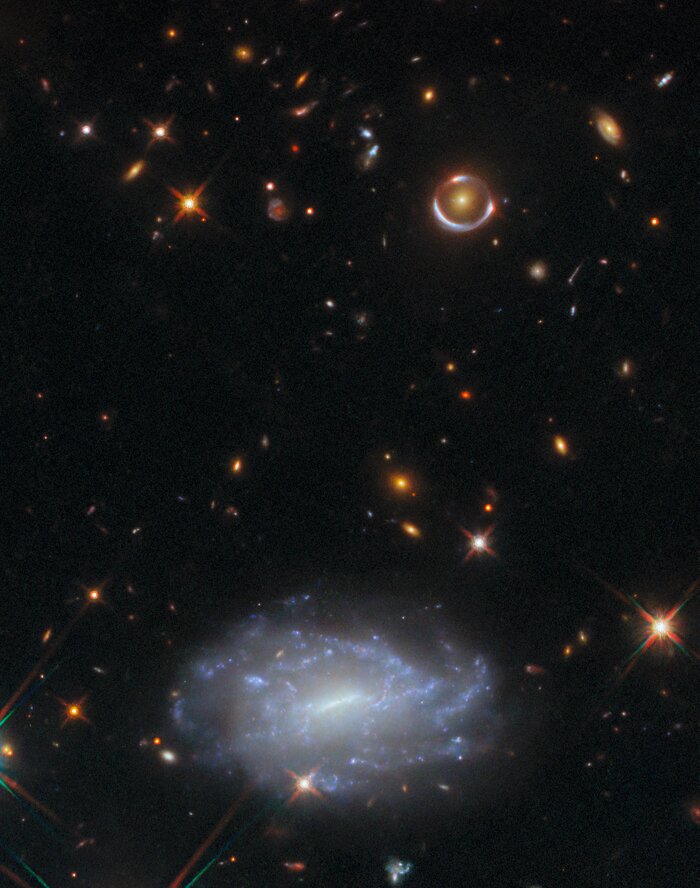Ringing in the new year
This week’s NASA/ESA Hubble Space Telescope Picture of the Week shows a tiny patch of sky in the constellation Hydra. The stars and galaxies depicted here span a mind-bending range of distances. Nearest to us in this image are stars within our own Milky Way galaxy, which are marked by diffraction spikes. The bright star that sits just at the edge of the prominent bluish galaxy is only 3230 light-years away, as measured by ESA's Gaia space observatory.
Behind this star is a galaxy named LEDA 803211. At 622 million light-years distant, this galaxy is close enough that its bright galactic nucleus is clearly visible, as are numerous star clusters scattered around its patchy disc. Many of the more distant galaxies in this frame appear star-like, with no discernible structure, but without the diffraction spikes of a star in our galaxy.
Of all the galaxies in this frame, one pair stands out in particular: a smooth golden galaxy encircled by a nearly complete ring in the upper-right corner of the image. This curious configuration is the result of gravitational lensing, in which the light from a distant object is warped and magnified by the gravity of a massive foreground object, like a galaxy or a cluster of galaxies. Einstein predicted the curving of spacetime by matter in his general theory of relativity, and galaxies seemingly stretched into rings like the one in this image are called Einstein rings.
The lensed galaxy, whose image we see as the ring, lies incredibly far away from Earth: we are seeing it as it was when the Universe was just 2.5 billion years old. The galaxy acting as the gravitational lens itself is likely much closer. A nearly perfect alignment of the two galaxies is necessary to give us this rare kind of glimpse into galactic life in the early days of the Universe.
[Image Description: Many mostly small, bright objects scattered over a dark background in space. In the top half on the right is an elliptical galaxy, a round light larger than the others, with a slightly warped ring of light around it. In the bottom half there is a barred spiral galaxy, big enough that we can see its bluish arms and its core in detail. Other objects include distant galaxies and nearby stars.]
Links
Credit:ESA/Hubble & NASA, D. Erb
About the Image
| Id: | potw2501a |
|---|---|
| Type: | Observation |
| Release date: | 6 January 2025, 06:00 |
| Size: | 1538 x 1950 px |
About the Object
| Name: | LEDA 803211 |
|---|---|
| Distance: | 622 million light years |
| Constellation: | Hydra |
| Category: | Galaxies |
Wallpapers
Coordinates
| Position (RA): | 13 56 53.20 |
|---|---|
| Position (Dec): | -23° 13' 33.79" |
| Field of view: | 1.01 x 1.29 arcminutes |
| Orientation: | North is 25.0° left of vertical |
Colours & filters
| Band | Wavelength | Telescope |
|---|---|---|
| Optical O II | 373 nm |
Hubble Space Telescope
WFC3 |
| Optical Ca II continuum | 390 nm |
Hubble Space Telescope
WFC3 |
| Optical V | 606 nm |
Hubble Space Telescope
WFC3 |
| Optical I | 814 nm |
Hubble Space Telescope
WFC3 |
| Infrared J | 1.25 μm |
Hubble Space Telescope
WFC3 |
| Infrared H | 1.6 μm |
Hubble Space Telescope
WFC3 |


